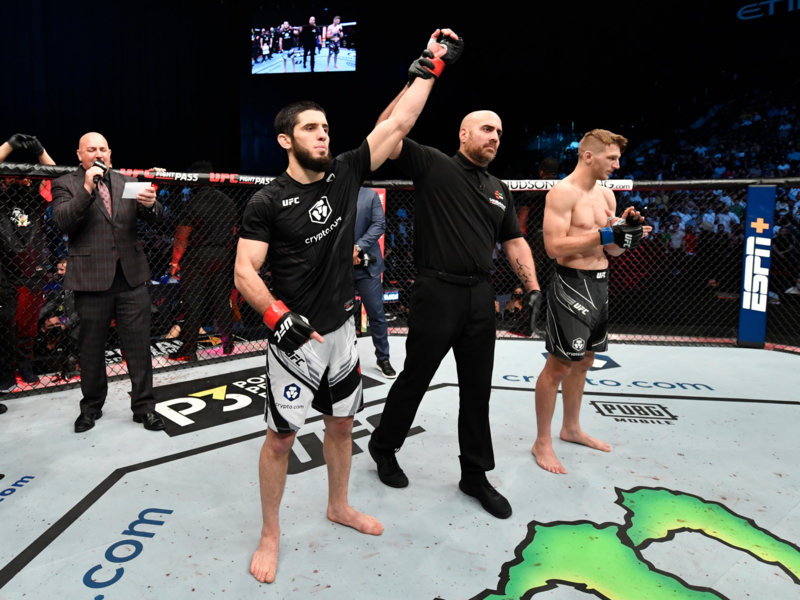Alexander Volkanovski lost Islam Makhachev fight for the lightweight title in Perth, Australia on February 12 at UFC 284.
His teammate Alex Volkanovski Dan Hooker posted a tweet in which he wrote that he knew how Islam Makhachev’s team called a nurse the week before the fight. Almost immediately, a photo circulated on the network, in which a Russian fighter has a mark on his left elbow. All this formed a suspicion against Makhachev: allegedly, the fighter could use droppers during fight week, which is prohibited by UFC anti-doping rules. In addition, a number of nuances have been omitted.
Fighters can inject themselves with intravenous injections in a volume of no more than 100 ml in 12 hours. If an athlete is using an approved drug, then proving excess bulk is extremely difficult.
Makhachev appeared with a bruise two days before the weigh-in (pictured below, mind not the crease in his left arm), despite fighters typically using droppers after the weight loss procedure to recover.
In the photos after the weigh-in and during the fight, Makhachev’s elbow is clean (below the photo after the weigh-in, 24 hours before the fight).
The anti-doping commission, almost simultaneously with the recording of this interview, released an official statement indicating that there was no reason to investigate the incident.
Practitioner Valentin Belyaevsky, who has worked with MMA fighters for a long time, asked us the most popular questions in this case.
No. 1. Does the mark in the first photo look like an injection or injection mark?
– In my opinion, it is exactly the same trace. As if two bruises were even visible there, that is, there were perhaps two injections.
No. 2. Is it possible to somehow understand from this trace that Islam put on itself a dropper with a volume of more than one hundred milliliters?
– Absolutely not. It could have been a blood draw, which means it could have been done by USADA or a local organization. It could have been a blood draw for tests that the fighter himself decided to do before the fight. It could have been any IV injection and, yes, it could have been an IV.
#3: What can a fighter give intravenously during fight week that makes sense, is USADA approved, and can go up to 100ml?
– Anything: B vitamins, legal and authorized; antioxidants, certain coenzymes, reducing agents, iron, nootropics, amino acids. Everyone drives weight differently, trains differently, and recovers different things.
No. 4. Makhachev’s bruise appeared before the weigh-in procedure and disappeared just closer to the weigh-in and the fight. Does this already destroy the version that Makhachev was picking up with a dropper after a heavy cut?
Yes, Islam had a bruise in the photo before the weigh-in. In principle, a person can walk away and recover without using a drip. It’s true.
#5. Gain 10kg drip-free in 36 hours* from weigh-in to fight – is it real?
– Really, of course (this time the fighters had a shorter recovery interval, but Makhachev also admitted after the fight that he was 2-3 kg lighter. – “”).
#6 Volkanovski’s team says the Makhachev people called a nurse to give him an IV. Haven’t athletes learned to put on droppers?
– First, I don’t believe they called the nurse, 200%. In countries like the United States and Australia, you can’t just call a nurse to your house and tell her to put you on this or that medicine. Secondly, in the team of Islam there may be people who themselves are able to put a drip or an intravenous injection. Third, let’s say again that it could have been a blood test.
No. 7. How would you investigate if they say it is still impossible to prove that the infusion of an illegal drug was more than 100ml.
– In general, to my memory, there are a few athletes who have been suspended under this paragraph of the regulations.
There must be either the testimony of a witness, or a video recording, or the athlete himself must confess. Since we are not looking here for a banned substance, but a banned method, there can only be circumstantial evidence. For example, an athlete, when he passes a test before a fight, must fill in a brief in the form, and there he must indicate which substances and in what dose he used the day before. For example, he writes riboxin and writes the dose and method – intravenous injection. Here, having determined the output of this substance, try to find the dose of this substance, if it was higher than indicated. But this is just borderline fantasy and it is not direct evidence, after which it will be necessary to re-examine witnesses, the athlete himself, etc. In general, even if an athlete did something like this, it is almost impossible to prove.
No. 8. How did you personally take the news of Makhachev’s suspicions? I hear some athletes, for example, say they still put on droppers.
– A week of combat can certainly be spent without a dropper. It is possible and many do. It’s just slower and harder without it. If you drive 15-18 kg, it is difficult without a dropper. But some are brought down within a month, while others are washed away in the final days.
In general, I read this story with laughter. It’s silly and a nitpicky kindergartener: “He dripped 4 ounces of saline and won a fight in five rounds.” We know it doesn’t work that way.
***
On February 19, attend the UFC Fight Night 219 tournament, the main event of which will be a fight in the women’s flyweight division between Brazilian Jessica Andrade and American Erin Blanchfield. The federal television channel “” will broadcast the tournament live from 03:00 Moscow time.
Source : MatchTV
I am Ashley Ortiz and I am a professional journalist working for Athletistic. My specialty is in sports journalism, particularly boxing. I have written articles for some of the most renowned publications on the subject, and my work has been featured across both print and digital media platforms.







